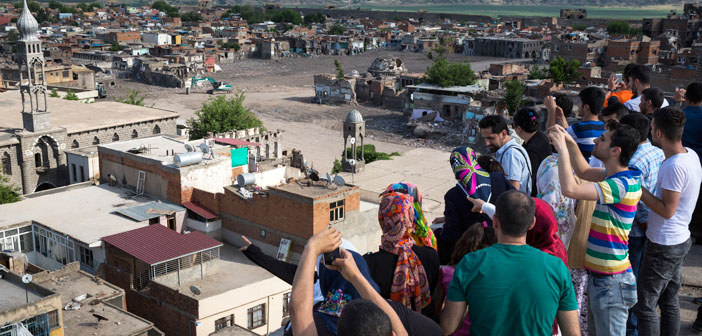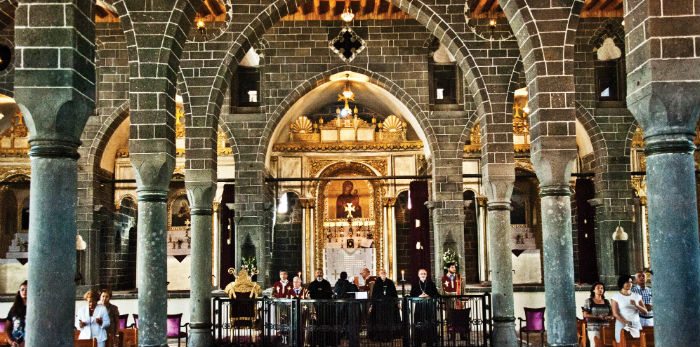With the lifting of the curfew in some places of Sur, which lasted for 6 months, the extent of the devastation is revealed. In fact, according to the people who saw the region, the real devastation happened in the places that are still under curfew.
The curfew declared in Sur province of Diyarbakir on December 2, 2015 was lifted on May 22 by the Governorship of Diyarbakir.
However, some regions in Sur are still under curfew. The region including Balıkçılarbaşı Neighborhood (known as Giaours' neighborhood) and Savaş Neighborhood, where Surp Giragos Church is located, are still under curfew.
Some of the residents of Sur, who went back to their neighborhoods after the curfew is lifted, went and saw the damaged houses and shops for themselves, and some of them went up to the roofs and tried to spot their houses in the places that are still under curfew. It is reported that a lot of houses are destroyed in Fatihpaşa and Hasırlı neighborhoods, where intense clashes took place.
A “street” in front of Surp Giragos
Conducting a preliminary examination in the region, Director of Spatial Management of Diyarbakir Fortress and Hevsel Gardens Nevin Soyukaya stated that the alleys characterizing the cultural identity of Sur are destroyed and turned into large boulevards and the shops are also destroyed. Yenikapı, which used to pass by Surp Giragos, was one of those alleys. Now, it is a large “street”. Soylukaya said: “When we looked down the neighborhood from the high buildings, we saw an unbelievable scene. After the destruction, construction vehicles removed the debris and what is left is holes on the ground. On Yenikapı Street passing by Surp Giragas, there were registered shops of Surp Giragos and Chaldean churches. We saw that all of those shops and the registered houses were demolished and the alley is turned into really large street. They also demolished the walls of the yards of Surp Giragos and Chaldean churches for enlarging the street.”
Stating that the Catholic Church is also damaged, Soylukaya said that a large space is formed on the north of the church. Soylukaya also said that the real destruction happened in the places that are still under curfew and summarized what happened as the following: “ 7-thousand-years-old Suriçi is turned into a plain land.”
Soylukaya also pointed out that the houses were turned into police stations: “They broke all the windows and doors. Furniture in some houses was also destroyed. They piled up sandbags in houses and on the roofs. We saw a lot of cartridges inside the houses. People tried to spot their houses. Some people couldn't find their houses and it is a real tragedy.” Soylukaya said that people don't want to leave Sur, though the houses are in terrible condition.
They tried to say, “Even if you come back, there wouldn't be anything left from you”
HDP Diyarbakir MP Sibel Yiğitalp participated in the investigation that was conducted by HDP. She also talked about the damage that was done to houses: “The doors were broken and the furniture were destroyed. Even the clothes of children were sloped around. What we saw is too terrible to be expressed. I guess they tried to say, ' Even if you come back, there wouldn't be anything left from you.'” Stating that there are bodies that people haven't been able to take for 4 months, Yiğitalp said, “You can witness a brutality that destroyed history. What is the reason of this hatred? History, life and economy is destroyed.”
Gaffur Türkay: we presented a petition to the district governorship
Gaffur Türkay from Surp Giragos Church Foundation said that they presented a petition to the district governorship to obtain a permit for entering the church, which is located in a place that is still under curfew: “Some people went and saw the church before. We think that the damage is not that substantial. There may be some damage inside the church. We want to go and see for ourselves.”
UNESCO waits for an answer from the Ministry of Culture
UNESCO hasn't made any statement about Sur, which is listed as cultural heritage. We asked about this issue to Soylukaya. She said that they sent a report to UNESCO, which in turn requested a report from the Ministry of Culture. Stating that they don't know anything about the process since the ministry doesn't provide any information, Soylukaya said, “However, we won't let what happened remain concealed. There are illegal practices in the region. How long could they keep it concealed?”





